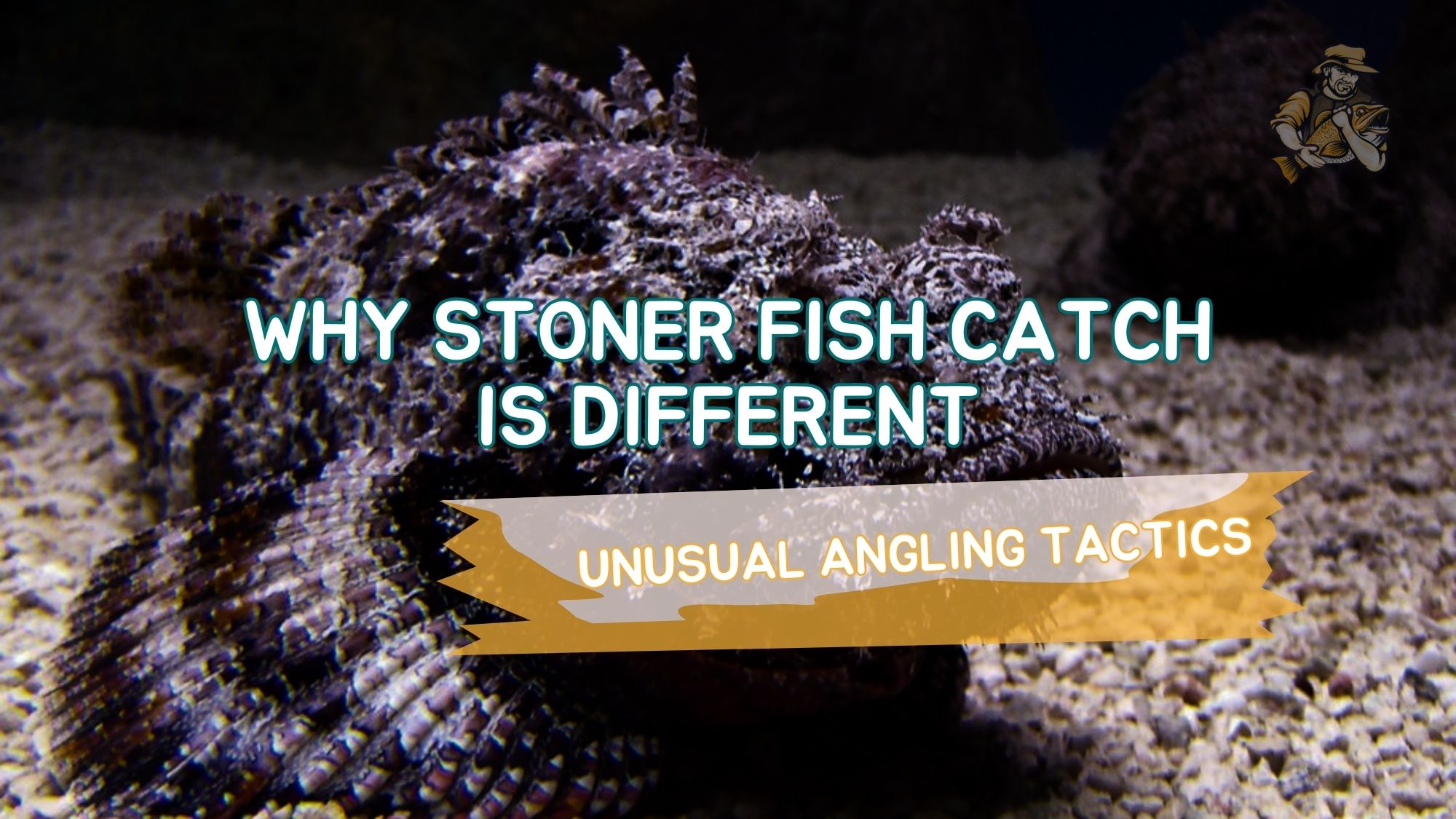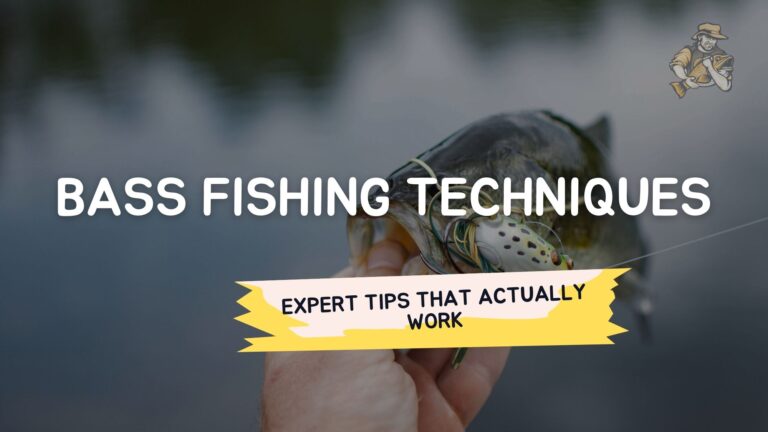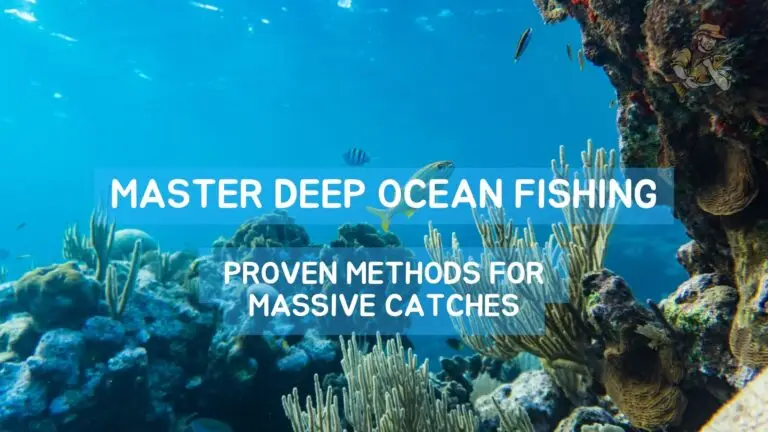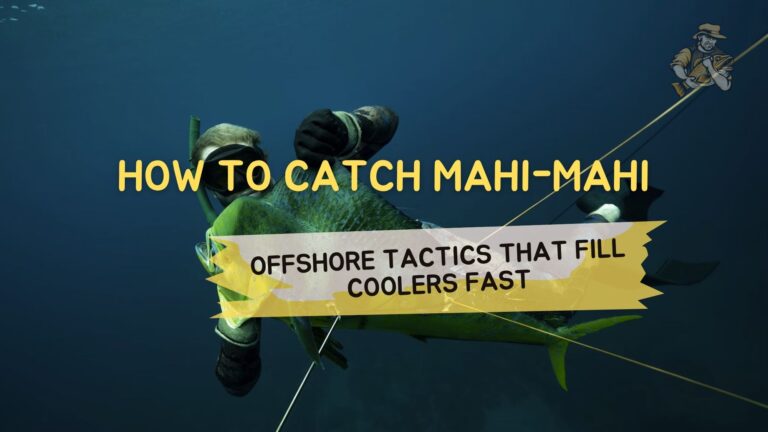Why Stoner Fish Catch is Different: Unusual Angling Tactics
By Adam Hawthorne | Last Modified: April 28, 2025

Let’s face it – some fish just act plain weird. Whether you’re an experienced angler or just starting out, you’ve probably encountered fish that seem completely uninterested in conventional lures or techniques. These “stoner fish,” as many anglers have come to call them, don’t follow the usual patterns and require a completely different approach. After spending more than 30 years on the water, I’ve encountered these oddball fish more times than I can count. Let me share what I’ve learned about these peculiar underwater residents.
What Makes a Stoner Fish Different from Regular Fish
The term “stoner fish” isn’t scientific, but it perfectly describes certain fish that display unusual, almost lethargic behavior patterns. These fish often seem disinterested, unresponsive to normal stimuli, or behave in ways that contradict typical feeding patterns. I first noticed this phenomenon on a muggy August morning at Lake Huron – my regular tactics weren’t just failing, they were being completely ignored as if the fish were operating on an entirely different wavelength.
What exactly causes this behavior? From my experience, several factors can contribute:
- Pressure changes that affect a fish’s swim bladder
- Unusual water temperatures (especially rapid changes)
- Oxygen depletion in certain water layers
- Post-spawn recovery periods
- Reaction to certain algal blooms
- Just plain weird individual fish personalities
I remember Finn, my black lab, staring intently at a group of bass near our dock that were just hovering motionless instead of striking at the abundant minnows. Even my dog seemed confused by their behavior!
These fish aren’t necessarily harder to catch – they just require a completely different mindset and approach. Standard retrieval speeds, common lure choices, and typical presentations often fail spectacularly with these oddballs.
Common Species That Display “Stoner” Behaviors
While almost any fish can occasionally exhibit these traits, certain species are notorious for their unpredictable, “stoner-like” behavior patterns:
- Smallmouth Bass – Especially in clear, deep lakes during summer thermoclines
- Walleye – Particularly after cold fronts or during mid-day in clear water
- Crappie – Often during seasonal transitions or unusual weather patterns
- Northern Pike – Sometimes after feeding heavily or during pressure changes
- Largemouth Bass – Especially in highly pressured lakes or during post-frontal conditions
I’ve found over the years that smallmouth bass are particularly prone to this behavior. During a fishing trip at Saginaw Bay, I watched in amazement as a group of decent-sized smallmouth completely ignored every presentation I tried for nearly an hour. I was about ready to give up when I accidentally dropped my plastic worm right on one’s head – and it lazily ate it almost as if annoyed. That accidental discovery led me to develop some of the unusual tactics I’ll share below.
Super-Slow Presentations That Work on Lethargic Fish
When dealing with stoner fish, speed is rarely your friend. In fact, I’ve found that presentations so slow they feel wrong often work best. These fish aren’t interested in chasing down fast-moving prey – they want something that practically swims into their mouth with minimal effort required.
On a memorable trip to the Au Sable River, I watched a group of trout that were ignoring every drift that passed over them. In frustration, I let my nymph just sit motionless on the bottom. To my surprise, after about 30 seconds, one of the fish slowly drifted over and casually sucked it in. This taught me an important lesson about patience that I’ve applied to many species since.
Some ultra-slow presentation tactics that have saved many fishing trips for me:
- Dead-sticking – Let your lure sit completely motionless for 30 seconds or more
- Micro-movements – The slightest twitch every 15-20 seconds
- Vertical presentations – Drop straight down to the fish rather than casting past them
- Super-slow retrieves – So slow your reel barely turns (one turn every 5-10 seconds)
- Bottom contact fishing – Maintaining continuous contact with the bottom while hardly moving
I remember watching my son Tommy’s face when I told him to just let his lure sit there without moving it. “But dad,” he protested, “it’s not doing anything!” Twenty seconds later, his rod almost jerked out of his hands as a bass that had been ignoring everything finally committed. Teaching kids patience through these techniques is an added benefit!
Unexpected Lure Choices for Unresponsive Fish
The lures and baits that work best for stoner fish often contradict conventional wisdom. While most anglers reach for flashy, noisy options when fish aren’t biting, I’ve found the opposite approach works better with truly lethargic fish.
On Lake Erie last summer, I was having an absolutely terrible day trying to catch walleye. I’d tried every standard walleye lure in my tackle box with zero success. Out of sheer frustration, I tied on a small black marabou jig – something I’d normally never throw for walleye. Within minutes, I’d hooked into a nice fish. Sometimes the most unconventional choice is exactly what these fish want.
Some surprising lure choices that have worked when nothing else would:
- Undersized options – Going dramatically smaller than conventional wisdom suggests
- Oversized options – Going much larger than typically recommended
- Drab, natural colors – Especially in clear water when conventional wisdom says “go bright”
- Baits with minimal action – Plastic worms with almost no appendages
- Scent-heavy baits – When visual appeal doesn’t seem to matter
I keep a separate tackle box that I call my “last resort” box. It contains the oddball lures that don’t make sense on paper but have saved more fishing trips than I can count. If you’ve ever caught a big bass on a tiny crappie jig or a pike on a finesse worm, you know exactly what I’m talking about.
Counter-Intuitive Retrieval Methods Worth Trying
When standard retrieve patterns fail, it’s time to experiment with approaches that seem almost backwards. I was forced to develop these methods after a particularly frustrating day on Lake Michigan where absolutely nothing was working despite marking plenty of fish on the sounder.
One morning while fishing from The Patience (my small fishing boat), I accidentally dropped my rod while reaching for my coffee. To my surprise, as my lure plummeted with no control whatsoever, a nice smallmouth grabbed it. This happy accident taught me that sometimes the most effective retrieve is barely a retrieve at all.
Some counter-intuitive retrieve patterns that have worked for me:
- The dead fall – Let your lure fall completely slack without any tension
- The accidental jerk – Random, uneven jerks with long pauses between
- The bottom drag – Dragging baits across the bottom with long pauses
- The hovering approach – Keeping a neutrally buoyant lure in the same spot
- The vertical drop – Dropping straight down rather than retrieving horizontally
A technique I stumbled upon by accident involves extremely long pauses – sometimes up to a full minute between movements. Most anglers don’t have the patience for this, but it can trigger strikes when nothing else will. During a particularly tough bite on Lake Huron, I actually set my rod down to retie another rig and came back to find it bent double with a nice smallmouth that had taken my temporarily abandoned lure.
Unusual Times and Locations to Target
Sometimes finding stoner fish means looking in places and at times that contradict conventional fishing wisdom. This isn’t about dawn and dusk being prime times – we all know that. This is about those weird, in-between periods and strange locations that most anglers overlook.
I’ll never forget a scorching hot July afternoon on Lake St. Clair when nobody was catching anything. Out of desperation, I moved to the shallowest flat I could find – less than a foot of water that was warm enough to be uncomfortable to touch. Logic said no fish would be there. Within minutes, I was catching bass after bass while boats all around me struggled in the “prime” deeper areas.
Some unexpected times and places to find actively feeding stoner fish:
- Super shallow water during midday heat – Sometimes fish move shallow when they “should” be deep
- The hottest part of the day – When conventional wisdom says fish should be inactive
- Directly under docks and boats – In the deepest shade possible
- Extremely clear, seemingly “empty” water – Where fish are present but highly pressured
- Unexpected structure types – Like lone stumps in otherwise featureless areas
One pattern I’ve noticed over my years of fishing in Michigan is that sometimes the most obvious, high-pressure spots produce well at the “wrong” times. A popular fishing pier that gets hammered all weekend might be surprisingly productive at 1 PM on a Tuesday when nobody else is around. The fish seem to let their guard down when the crowds disappear.
Pressure and Weather Pattern Impacts on Fish Behavior
I’m not going to pretend I understand all the science behind how barometric pressure affects fish – plenty ofscientific studies on barometric pressure effects have covered that. But I can tell you from experience that rapid pressure changes create some of the strangest fish behavior you’ll ever encounter.
My fishing logs from the past decade show an unmistakable pattern: some of my most difficult days on the water have come during sharp barometric rises after a storm system passes. The fish seem to shut down almost completely, or they switch to feeding patterns that seem completely illogical.
Last spring on Lake Superior, I experienced this firsthand when a fast-moving storm front passed through. Before the front, the lake trout were hitting consistently on standard patterns. After the pressure spiked, they completely disappeared from their usual haunts. I finally located them in much shallower water than they should have been in – and they would only hit lures dragged motionlessly along the bottom.
Here’s what I’ve observed about pressure changes and fish behavior:
- Falling pressure (before storms) – Often triggers aggressive feeding
- Stable low pressure – Usually provides consistent fishing
- Rapidly rising pressure – Creates the most “stoner-like” behavior
- Stable high pressure – Fish often establish predictable patterns
During rapidly rising pressure situations, I’ve found success by:
- Downsizing presentations dramatically
- Slowing down even more than usual
- Focusing on bottom-oriented presentations
- Looking for fish in unusual locations
- Using scent to trigger reaction strikes
One April morning after a major cold front, I found bass in the Au Sable River acting particularly strange. They had moved from their usual haunts to unusual shallow pockets, and they would only hit baits that were literally sitting still on the bottom with no movement whatsoever. I caught several nice fish by simply leaving a Texas-rigged worm motionless for minutes at a time.
Water Clarity and Its Effect on Feeding Behavior
Water clarity dramatically affects how these already-strange fish behave. What works in stained water won’t necessarily work in gin-clear conditions, and vice versa.
Some fishing experts insist that clear water requires certain presentation adjustments, but I’ve found that “stoner fish” often break these rules. During a particularly tough bite on an ultra-clear section of Lake Michigan, conventional wisdom said to use natural colors and small presentations. After hours of frustration, I switched to a bright orange jig that was theoretically all wrong for the conditions – and immediately started catching fish.
Observations I’ve made about clarity and stoner fish behavior:
- Ultra-clear water – Fish often respond to extremes (either tiny, natural presentations or large, bold ones)
- Moderately clear water – Standard presentations might work, but retrieval speed becomes crucial
- Stained water – Contrast and vibration often matter more than color or size
- Dirty water – Scent becomes the dominant factor in triggering strikes
One memorable day on a gin-clear lake in northern Michigan, I watched smallmouth bass completely ignore the subtle, natural-colored lures that should have worked. Out of desperation, I tied on a bright purple worm that seemed ridiculous for the conditions. To my surprise and my fishing buddy’s disbelief, it started producing immediately. Sometimes the most illogical choice is exactly what works.
Unconventional Tackle and Rigging Options
Standard rigging methods often fail with truly difficult fish. Over the years, I’ve developed some rather unusual approaches that go against conventional wisdom but have saved many tough days on the water.
During a particularly difficult tournament on Lake Erie, I was struggling to get walleye to commit to standard presentations. In desperation, I rigged a worm harness backward – with the spinner in front of the worm rather than behind it. This completely violated conventional rigging wisdom, but it produced immediate results in those tough conditions.
Some unconventional rigging approaches that have worked when standard methods fail:
- Backward rigging – Putting components in reverse order
- Mixed media rigs – Combining elements from different lure types
- Intentional tangling – Creating unusual action through controlled chaos
- Leader-less presentations – When extreme stealth matters more than bite protection
- Over-weighting – Using much heavier weights than conventional wisdom suggests
I keep a separate section in my tackle box specifically for “emergency” components that I can use to create these bizarre rigs when nothing else is working. This includes odd-sized hooks, non-standard weights, and components that can be mixed and matched in unusual ways.
My fishing buddy James laughed when I showed him my “panic box” of weird tackle components. “That’s ridiculous,” he said. The next day when we were getting skunked on Lake Huron and my emergency rig was the only thing producing fish, he sheepishly asked if I had any extra components he could try.
The Importance of Mental Flexibility
Catching stoner fish successfully requires a completely different mindset than regular fishing. If you’re stubborn or set in your ways, you’ll walk away frustrated and empty-handed.
I learned this lesson the hard way during a fishing trip on the Au Sable River with my brother Michael. While I stubbornly continued to use conventional techniques in spite of clear evidence they weren’t working, he switched to an unusual approach that seemed ridiculous to me. By the end of the day, he’d caught several nice fish while I had nothing to show for my efforts.
Mental approaches that help when dealing with difficult fish:
- Expect the unexpected – Be prepared for fish to behave illogically
- Embrace failure as information – Each failed approach tells you what NOT to do
- Question conventional wisdom – Sometimes the “wrong” approach is right
- Think like a contrarian – If everyone else is fishing one way, try the opposite
- Slow down your decision making – Resist the urge to constantly change tactics
I’ve come to appreciate that catching these challenging fish often comes down to an almost Zen-like state of acceptance. Instead of fighting against their unusual behavior, I’ve learned to observe carefully and adapt accordingly. Some of my most rewarding catches have come when I completely abandoned what I “knew” should work and simply responded to what I was seeing.
How Electronics Can Help Identify “Stoner” Fish
Modern electronics have revolutionized how we locate and catch fish, but they’re particularly valuable when targeting these challenging specimens. On Lake Michigan last summer, my graph showed fish suspended at mid-depth, but they weren’t responding to any presentation. By watching how they reacted – or didn’t react – to different lures on the sonar, I was able to fine-tune my approach until I found something they would hit.
A good fishfinder can show you:
- Fish positioning relative to structure – Often unusual in stoner fish
- Reaction to lure presentation – Or lack thereof
- Subtle movement patterns – That might indicate feeding triggers
- Unusual schooling behavior – Or lack of normal schooling
- Depth preferences that contradict seasonal patterns – A common stoner fish characteristic
I’m not suggesting you need expensive electronics to catch fish. I caught plenty before electronics were common. But modern technology can certainly help you understand what’s happening below the surface when fish are behaving strangely. I’ve found my modest Lowrance unit to be invaluable for cracking the code on tough days.
One morning on Lake Erie, I was marking plenty of walleye but couldn’t get them to bite. By switching my unit to the highest sensitivity and watching carefully, I noticed they would rise slightly toward certain presentations before turning away. This subtle observation led me to downsize dramatically and slow my presentation, resulting in immediate success.
FAQs About Catching Difficult “Stoner” Fish
What’s the best time of year to catch stoner fish?
While you can encounter these challenging fish year-round, I’ve found late summer and early fall to be particularly notorious for producing this behavior. During these transitional periods, fish often exhibit the most unpredictable behavior patterns. Last September on Lake Michigan, I witnessed this firsthand when seemingly active fish on my sonar completely ignored standard presentations but would occasionally hit bizarre alternatives like a jig dragged motionlessly along the bottom.
The seasonal transition effects on fish behavior are well documented, but the standard recommendations don’t always apply to truly difficult fish. I’ve found that the most important factor isn’t the season itself but rather identifying when fish are in these unusual states and adapting accordingly.
Do stoner fish feed differently than other fish?
Yes, absolutely. These fish often abandon normal feeding patterns in favor of opportunistic, energy-efficient approaches. Instead of actively chasing prey, they may wait for easy opportunities or focus on unusual food sources. During a particularly tough day on Lake Huron, I observed smallmouth bass completely ignoring crayfish and minnows but occasionally picking off tiny insects from the surface – behavior that contradicted everything I thought I knew about their feeding preferences.
When targeting these fish, it’s important to recognize their altered feeding behavior. They’re not necessarily feeding “less” – they’re just feeding differently. Understanding this distinction has helped me catch fish when others around me struggled.
What lures should I start with when nothing seems to be working?
While there’s no universal answer, I’ve had the most consistent success with subtle, scent-based plastics when dealing with truly difficult fish. A simple plastic worm or small creature bait fished with minimal movement often produces when flashier options fail. On a particularly challenging day on the Au Sable River, a 4-inch black plastic worm fished with practically no movement was the only presentation that produced consistent strikes.
However, it’s important to note that the specific lure often matters less than how you present it. The key is fishing much slower than you think necessary and being prepared to make unusual adjustments to your retrieve pattern. Some anglers struggle with the extreme patience required to fish in this style, but it’s often the difference between success and failure with these challenging fish.
How can I tell if I’m dealing with “stoner fish” versus just no fish?
This is a crucial distinction. Modern electronics make this determination easier, but there are other clues as well. If you’re marking fish on your sonar but getting no response, or if you’re seeing fish but they’re ignoring your presentations, you’re likely dealing with stoner fish. Visual cues like fish following but not striking or unusual positioning can also indicate this behavior.
I recall a frustrating day on Lake St. Clair where I could actually see bass holding in shallow water but they wouldn’t hit anything. After cycling through my entire tackle box with no success, I finally tied on a small crawfish-colored creature bait. When I let it sit motionless directly in front of a fish for over a minute, it finally inhaled it with barely any movement. That experience taught me that sometimes fish are present but require a completely different approach.
Does weather affect stoner fish behavior more than regular fish?
In my experience, absolutely yes. These fish seem particularly sensitive to barometric pressure changes, frontal systems, and rapid temperature shifts. My fishing logs show a clear pattern: some of my toughest days have come immediately after significant weather changes, particularly cold fronts with rising pressure.
During a trip to Lake Superior, I experienced this dramatically when a fast-moving cold front transformed active lake trout into seemingly comatose fish that ignored everything. After testing multiple approaches, I finally found success by downsizing dramatically and fishing deeper than usual with painfully slow presentations. Learning to recognize these weather-induced behavioral changes has helped me adapt when conditions suddenly change.
Conclusion: Adapting to the Challenge of Stoner Fish
After more than three decades of fishing Michigan’s waters, I’ve come to appreciate the challenge of these difficult, “stoner” fish. While they can certainly be frustrating, they’ve also made me a much better angler by forcing me to think outside conventional tactics and adapt in ways I never would have otherwise.
The key takeaway is that successful fishing often requires abandoning what you “know” should work in favor of what the fish are telling you actually works. Sometimes this means techniques that seem illogical or contradictory to established wisdom. Other times it means having the patience to slow down dramatically when every instinct tells you to speed up and cover more water.
I’ve learned to keep a separate box of “emergency” lures and components for these situations, and they’ve saved countless trips from disaster. A strange rig or unusual presentation might look ridiculous to other anglers, but results speak for themselves. Some of my most memorable catches have come under these difficult conditions precisely because they required solving a complex puzzle rather than following an established pattern.
If you find yourself facing these challenging fish, embrace the opportunity to grow as an angler. Be willing to try approaches that seem wrong. Have the patience to fish painfully slowly. And most importantly, pay close attention to the subtle cues that might indicate a pattern within the apparent chaos of stoner fish behavior.
The satisfaction of cracking the code on these difficult fish far exceeds the routine catch of cooperative ones. And in my experience, the lessons learned while pursuing these challenging fish will improve your success across all fishing situations.

Meet Adam Hawthorne
I’m a lifelong fishing enthusiast who’s spent years exploring rivers, lakes, and oceans with a rod in hand. At Fishing Titan, I share hands-on tips, honest gear reviews, and everything I’ve learned about fish and ocean life, so you can fish smarter and enjoy every cast.
Share:

Meet Adam Hawthorne
I’m a lifelong fishing enthusiast who’s spent years exploring rivers, lakes, and oceans with a rod in hand. At Fishing Titan, I share hands-on tips, honest gear reviews, and everything I’ve learned about fish and ocean life, so you can fish smarter and enjoy every cast.
Related Articles

Bass Fishing Techniques: Expert Tips That Actually Work
Bass fishing has been my passion for over three decades, and if there’s one thing I’ve learned, it’s that the right technique makes all the…

Master Deep Ocean Fishing: Proven Methods for Massive Catches
There’s something almost magical about heading far offshore, where the continental shelf drops away and you’re floating above thousands of feet of water. Deep ocean…

Utah Fishing License Guide: Costs, Requirements & Hidden Tips for 2025
When I first planned a fishing trip to Utah’s beautiful waters about a decade ago, figuring out the licensing requirements felt more complicated than actually…

How to Catch Mahi-Mahi: Offshore Tactics That Fill Coolers Fast
I still remember my first encounter with mahi-mahi (also called dolphin fish or dorado). We were about 20 miles offshore from Key West on a…
